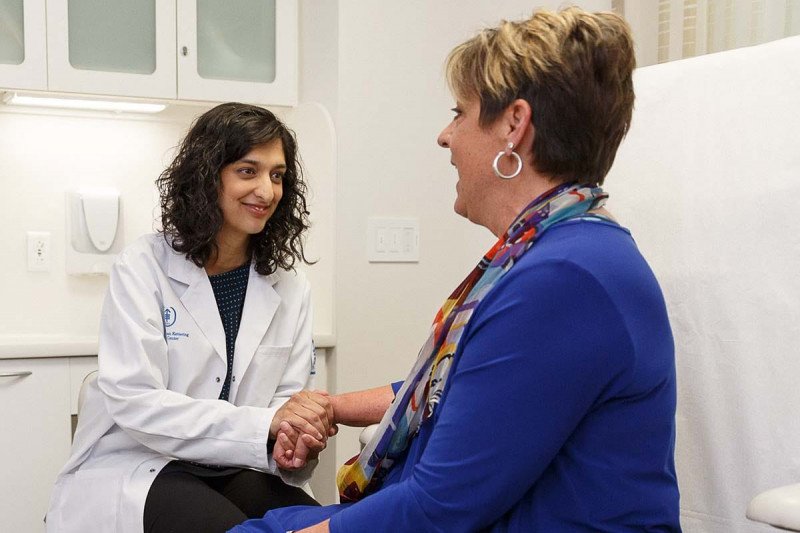
MSK doctors such as medical oncologist Anita Kumar provide compassionate, comprehensive care for lymphoma patients using the most advanced treatments.
Lymphoma is a type of cancer that starts in white blood cells called lymphocytes. These cells play an important role in the immune system, helping your body fight infections and other diseases.
Lymphoma develops when lymphocytes grow and multiply abnormally. This can happen if the genes that control cell growth no longer work properly. Then the cells grow uncontrollably or live longer than they should.
What are the types of lymphoma?
There are more than 70 different types of lymphoma. They range from indolent (slow growing) to highly aggressive. Lymphomas are categorized into two broad groups: non-Hodgkin lymphoma and Hodgkin lymphoma.
What causes lymphoma?
There are many types of lymphoma and in most cases, there is no clear reason why lymphoma develops. Your risk for certain types of lymphoma can increase if your immune system is suppressed. For example, organ or bone marrow transplantation, treatment with immunosuppressive drugs, and the presence of autoimmune diseases may increase the risk for certain types of lymphoma.
Being exposed to some infections may also increase your risk of developing some types of lymphoma. These include the bacteria called Helicobacter pylori, the hepatitis C virus, the HIV virus, or the human T cell leukemia/lymphotropic virus.
In rare cases, a very uncommon form of lymphoma has been linked to breast implants, particularly those with a textured surface. This lymphoma has occurred in people who chose implants for cosmetic reasons as well as people who had implants during reconstructive surgery after breast cancer.
Learn more about breast implant-associated anaplastic large cell lymphoma (BIA-ALCL).
What are the treatments for lymphoma?
Your treatment depends on the type of lymphoma you have and how far the disease has spread. Thanks to advances in molecular and genetic testing and improvements in our understanding of the biology of different tumor types, we are able to tailor highly individualized treatments. Some slow-growing lymphomas may not require treatment and can instead be carefully monitored. This approach is called active surveillance. For other lymphomas, very effective treatments are available, including chemotherapy, targeted therapies, radiation, stem cell transplantation, immunotherapy, and other therapies.
Why should I choose Memorial Sloan Kettering for lymphoma treatment?
Our lymphoma team delivers compassionate cancer care of the highest quality. We take into account each person’s individual needs to develop a personalized treatment plan. Memorial Sloan Kettering’s specialists have vast depth and breadth of experience in all subtypes of lymphoma. The result is the best outcome for the more than 1,200 lymphoma patients we treat each year.
Choose MSK because we offer:
-
A multidisciplinary team that brings together more than 30 experts. Many of them are internationally renowned in their diverse specialties, including medical oncology, radiology, radiation oncology, pathology, genetics, bone marrow transplant, and symptom management.
-
Collaboration among these experts. They meet weekly to confer on each individual case and draw on their vast experience to determine the best treatment options.
-
Expertise in recognizing even the smallest differences in lymphoma types and in diagnosing rare lymphomas that most doctors will never see.
-
The latest techniques and state-of-the-art technology. This allows our doctors to determine the extent and clinical features of your lymphoma with great accuracy.
-
Access to new treatment strategies based on our understanding of why and how lymphoma develops and grows. This includes alternatives to traditional chemotherapy that more precisely target cancer cells while sparing normal ones. We also use safer forms of radiation and new therapies that stimulate the immune system to fight cancer. Sophisticated molecular and genomic profiling of your lymphoma allows us to offer targeted therapy and individualized treatment plans.
-
One of the largest and most innovative clinical trial programs for lymphoma in the world. Our patients have access to novel treatments that could be tomorrow’s cures.
-
Great flexibility in how and where you receive your treatment. Our specialists are conveniently located not just in Manhattan but also at our regional outpatient locations in New Jersey, as well as in Westchester County and on Long Island. This allows you to receive the same outstanding care from MSK’s doctors closer to home.
-
A comprehensive program to support the well-being of every patient physically, emotionally, spiritually, and otherwise, during and after treatment. Our doctors work with a team of specialists who address any needs that arise during the diagnosis, treatment, and survivorship of our patients.
-
An active research program focusing on the most promising new approaches to diagnosing and treating lymphoma. Our areas of study include immune therapy, genomic profiling, and combination therapies targeting specific molecular markers.
- A personalized survivorship care plan with the medical guidance you’ll need to go back to a healthy life after lymphoma. Watch a video to learn more about MSK’s Adult Survivorship Program.









